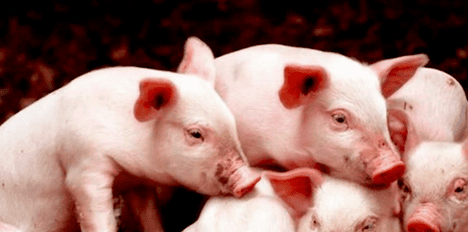Representative diseases of circovirus include: pig post-weaning multisystem wasting syndrome, sow reproductive failure, weaned pig and breeding
Fat pig respiratory disease, porcine dermatitis nephrotic syndrome, pig diarrhea Syndrome and central system diseases in piglets.
Because circovirus can destroy the immune system of pigs, causing immunosuppression and secondary immune deficiency, this disease is often associated with PRRS, parvovirus, and pseudovirus. Mixed infections or secondary infections such as rabies, Haemophilus parasuis, asthma, pleuropneumonia, Pasteurella
and Streptococcus.

Porcine circovirus disease is a type of viral infectious disease characterized by immunosuppression. The clinical manifestations are complex. Circovirus is seriously invasive to immune organs and can lead to a high degree of suppression of the body's immune system. In layman's terms, circovirus can render vaccine immunity ineffective and the body's immunity weaken or disappear. Representative diseases caused by circovirus include post-weaning multisystem wasting syndrome, sow reproductive disorders, respiratory diseases of weaned and fattening pigs, porcine dermatitis nephrotic syndrome, porcine diarrhea syndrome and central system diseases of piglets.
1. Porcine immunodeficiency syndrome
1: The pig body’s resistance is reduced and it is more susceptible to secondary infection with other pathogens. This is also related to the mixed infection of circovirus and many pig diseases. reason.
2: Attenuated vaccines or low-pathogenic microorganisms can cause disease.
3: No immune response is produced after vaccination.
4: Repeated attacks and no response to treatment.
2. Porcine multisystem wasting syndrome
The most common symptoms are progressive weight loss or growth retardation in pigs, which is also the necessary clinical basis for the diagnosis of PMWS. Other symptoms include anorexia, It is characterized by depression, slow movement, pale skin, disheveled coat, difficulty breathing, and coughing. Less common symptoms are diarrhea and central nervous system disorders. The morbidity rate is generally low and the mortality rate is high.
It can occur in all seasons and mainly affects piglets 2 to 3 weeks after weaning (40 to 70 days old). The disease also occurs in piglets in pig farms that implement early isolation and weaning. The virus can be excreted with feces and nasal secretions, spread through the digestive tract or may be vertically transmitted to piglets through the placenta. The morbidity and mortality rates are uncertain; when it is endemic, the morbidity and mortality rates are low, but in acute outbreaks, The morbidity rate can reach 50%, and the mortality rate is as high as 20% to 30%. The mortality rate of piglets will be higher if the disease is mixed with porcine parvovirus or porcine reproductive and respiratory syndrome virus, Streptococcus, Pasteurella multocida and Haemophilus parasuis.
3. Porcine Respiratory Disease Syndrome
Refers to the intractable pneumonia of fattening pigs, which is difficult to cure, easily relapses, and eventually dies due to lung failure secondary to other infections. Generally, it is a serious respiratory disease caused by secondary infections such as circovirus, Mycoplasma pneumoniae, swine influenza, reproductive and respiratory syndrome, Pasteurella, Haemophilus parasuis, and Actinobacillus pleuropneumoniae. The mortality rate can reach more than 20%.
4. Porcine dermatitis and nephrotic syndrome
In an outbreak of PDNS in England, the incidence rate reached 14%, and the mortality rate could reach 30%. Recently, the incidence rate of this disease in the suburbs of Shanghai has reached 11%, and the mortality rate has reached 40%. The disease mostly occurs between 12 and 14 weeks of age. Sick pigs show anorexia, sluggishness, paleness, fever, conjunctivitis, difficulty breathing, diarrhea, and weight loss. Round or irregular necrotic lesions appear on the skin.
It mainly harms growing and fattening pigs, with a mortality rate of 15% to 20%. Pigs are stunted and produce slowly. Adult pigs are generally latently infected and do not show any symptoms or lesions, but their growth rate decreases significantly.

5. Porcine diarrhea syndrome
Fattening pigs raised for fattening are in many cases Unexplained diarrhea that persists for a long time. Its clinical manifestations include diarrhea and normal defecation alternating, the medication effect is not obvious, and the disease is repeated and delayed. The cause is chronic enteritis caused by circovirus damaging intestinal tissue, intestinal tissue failure, and intestinal wall atrophy. This type of enteritis is very difficult to treat.
6. Pig central nervous system diseases
1: Congenital tremor in piglets. Piglets tremble constantly after birth and often starve to death because they cannot get milk. If you strengthen care and ensure that the piglets can eat colostrum, are not cold, and are not hungry, they can usually survive in a few weeks.
2: Fattening pigs were paralyzed for unknown reasons. Fattening pigs suddenly become inflexible and paralyzed in their hind legs.
7. Reproductive disorders in infected sows include abortion, stillbirth, increased mummified fetuses, and increased mortality before weaning.
To date, diseases caused by circovirus type 2 have attracted increasing attention.
Porcine post-weaning multisystem wasting syndrome mainly occurs in piglets within 2-3 weeks after weaning. It usually occurs 2-3 days and one week after weaning, with an incidence rate of 20%-60%. , the case fatality rate is 5%-35%.
Porcine dermatitis nephrotic syndrome usually occurs in pigs aged 12-14 weeks, with an incidence rate of 12%-20% and a mortality rate of 5%-35%.
Congenital tremor in piglets is more common in piglets within one week of birth.
Because circovirus can destroy the immune system of pigs, causing immune suppression and secondary immune deficiency, this disease is often associated with PRRS, parvovirus, pseudorabies, and porcine parahaemophilus. coli, asthma, pleuropneumonia, Pasteurella and Streptococcus and other mixed infections or secondary infections.
Baicao Mule’s recommended prevention and control plan:
Yuanlan Anti + Qi and Blood Dual Tonic is mainly used to suppress some immunosuppressive viral diseases such as circulatory disease, blue-ear disease, and influenza. It has a good prevention and treatment effect on mixed infections of bacterial diseases such as paraswine, streptococcus, thoracic disease, porcine epidemic, etc.

 扫一扫微信交流
扫一扫微信交流
发布评论